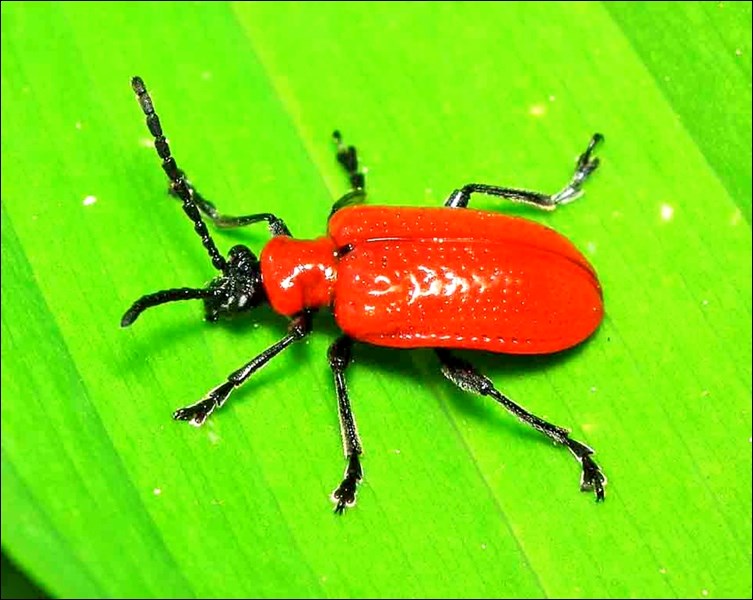If you like lilies and have enjoyed their carefree space in your garden, count yourself fortunate. In 1943 a small, red beetle with an insatiable appetite for lily foliage was introduced by mistake in Montreal. The scarlet lily leaf beetle has made it across the country to Saskatchewan and those who have experienced this beetle are aware of how this tiny creature devours leaves of lilies and fritilarias leaving a bare stem in place of the sturdy well-leafed stem adorned with a crown of flamboyant, trumpet-shaped blooms.
This beetle is bright red, about eight to 10 millimetres long, with a black head, large beady black eyes and long, black antennae. The female beetle will lay two to 16 reddish-orange eggs on the underside of the lily leaves in a curvy, irregular line. Within eight to 10 days these eggs hatch into the larval stage, which is an ugly worm whose only reason for living is to eat.
Young larvae are black while older stages are yellowish-white with a black head. The larvae form a fecal shield, the feces deposited on the back of the larvae that not only disguises the larvae but protects the little blighters from heat. These larvae feed for about three weeks and, when mature, will enter the soil, pupate and emerge as adults after about three more weeks. They will spend the remainder of the season happily munching on your lilies and head underground to over winter. In spring, they will emerge in early May, mate and continue this cycle.
There are some biological controls that are showing effectiveness, but the best approach is to pick and destroy them as beetle, eggs or larvae. Start looking for eggs in early spring and then watch for the larvae. Beetles move quickly and then drop to the ground with legs in the air, making them difficult to see. When hunting for the adults carry a pail of soapy water to drop the beetles into.
Take care to not bring any of these critters into your garden. Unpot new lilies over newspaper and look for eggs, larvae and adults. As an alternative to plants, choose to plant bulbs from a reputable source and as a safeguard, soak the bulbs for a few minutes in a 10 per cent bleach solution prior to planting.
If you are interested in learning more about lilies then the Canadian Prairie Lily Society is a great choice. Also, if you are close to Parkside, visit Honeywood Nursery, a non-profit provincial heritage site that is the location that many heritage Asiatic lilies were bred by Bert Porter.
— Hanbidge is a horticulturist with the Saskatoon School of Horticulture and can be reached at 306-931-GROW(4769); by email at growyourfuture@gmail.com; facebook: @schoolofhort; twitter: @hortiuclturepat; instagram: patyplant or check out our website at saskhort.com



